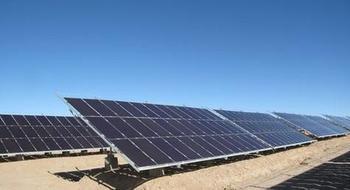 Recently, the United States Solar Energy Association (SEIA) and the industry research institute GTM Research Institute jointly issued a report that due to the completion of a large number of utility projects in 2012, the US photovoltaic installed capacity increased by 76%, reaching a record of 3,313 MW.
Recently, the United States Solar Energy Association (SEIA) and the industry research institute GTM Research Institute jointly issued a report that due to the completion of a large number of utility projects in 2012, the US photovoltaic installed capacity increased by 76%, reaching a record of 3,313 MW. The report pointed out that in 2013, the growth rate of photovoltaic installations in the United States may slow down, and the increase is expected to be around 30%. The total installed capacity is expected to reach 4,300 megawatts. By 2016, the US photovoltaic market will usher in new developments. There will also be a new round of significant growth in installed capacity.
According to the statistics of the report, as of the end of 2012, the cumulative installed capacity of photovoltaics in the United States has reached 7,221 megawatts. Among them, 8 of the 10 largest utility-grade PV projects have been connected to the grid. The installed capacity of utility-grade PV projects has doubled to 1,782 megawatts; there is also a utility-grade 4,000 MW installed capacity. Photovoltaic projects are under construction; another over 8,000 megawatts of electricity purchase agreements have been signed.
As the largest solar market in the United States, California’s installed capacity reached a new record in 2012, with 1,033 megawatts of additional installed capacity; followed by Arizona, with 710 megawatts of new installed capacity; New Jersey’s 2012 new installed capacity of 415 Megawatts, with a total installed capacity of 1,043 megawatts, is up 26% from 2011. Although this year's solar installation growth may slow down, New Jersey is still expected to become the second largest market for commercial solar energy in the United States. In addition, Massachusetts added 129 MW of photovoltaic capacity in 2012, and 74 million watts of new capacity in Maryland. .
In 2012, the U.S. market accounted for 11% of the global PV market and reached its highest level in 15 years. The report pointed out that this has a lot to do with the 2012 US PV module market continuing to oversupply. In 2012, the installed price of new photovoltaic projects in the United States dropped by about 27%, driving the market to add about 90,000 photovoltaic power generation systems.
At the same time, according to the report, the US residential solar energy market installed 488 MW of projects last year, a year-on-year increase of 62%. Of the 83,000 new residential solar energy systems added, more than 50% were completed through leasing and purchase agreements and were funded by third parties. GTM estimates that by 2016, this third-party-funded residential solar energy market is expected to reach US$5.7 billion.
In addition, the report predicts that in 2013 the US solar thermal solar market will have a substantial increase. The main reason is that BrightSource’s 392 MW Ivanpa Power Station in California and Abengoa’s 280 MW Solana Power Station in Arizona are nearing completion. Last year, only the 30 MW Alamosa Solar Thermal Project of Cogentrix in Colorado was put into production.
The report also pointed out that this year's small-scale utility-grade solar energy market is also expected to achieve growth in the United States, especially small-scale systems of 1 MW to 5 MW, while the locations are mainly concentrated in North Carolina and California.
However, the growth momentum of the US solar energy market cannot be maintained for a long time. The report pointed out that with the completion of the new projects, it is expected that the US solar power installation will likely temporarily decline in the next two years. Although some new power purchase agreements will be signed in the future, the development of utility-grade solar energy projects will gradually slow down as many utility companies will face the signing of new renewable energy ratio standard contracts.
Investors are also very optimistic about the US solar market. In January of this year, Sino-U.S. Energy Holdings, a subsidiary of Warren Buffett, spent 2.5 billion U.S. dollars to purchase photovoltaic power plant projects from U.S. Solar Power. According to a joint report issued by SEIA and GTM, the way the US solar market will be diversified this year, such as real estate trust investment, fundraising, and issuance of securities, etc., are all likely to gain a firm foothold in the solar energy market.
In addition, solar energy has also become the clean energy industry with the largest number of job creation opportunities in the United States in 2012. Data shows that in the last quarter of 2012, the solar industry created about 3,300 jobs in the United States, which exceeds the total number of jobs created by wind, biomass, biogas, and geothermal energy. Among them, the largest number of jobs were created in the field of power generation, followed by manufacturing, energy storage, and transmission. At the same time, the vigorous development of the solar energy market has also led to the employment of the US auto industry and some clean energy support industries. Geographically, the employment situation on the west coast of the United States is the best. Among them, the most prosperous state of the solar industry is California.
Powder Activated Carbon,Powder Activated Carbon Msds,Activated Carbon Powder
Carbon Additive,Activated Carbon Co., Ltd. , http://www.nhactivatedcharcoal.com